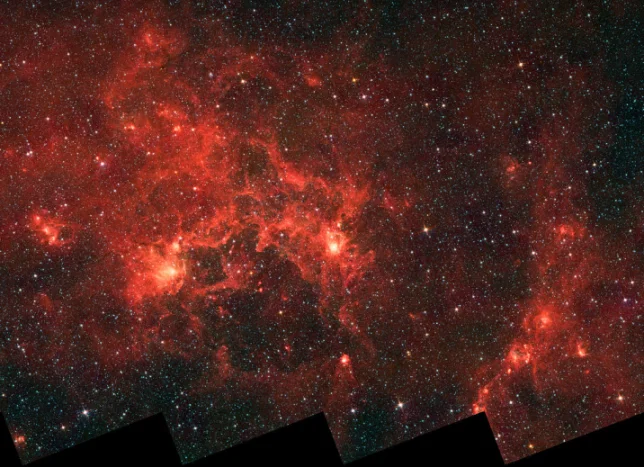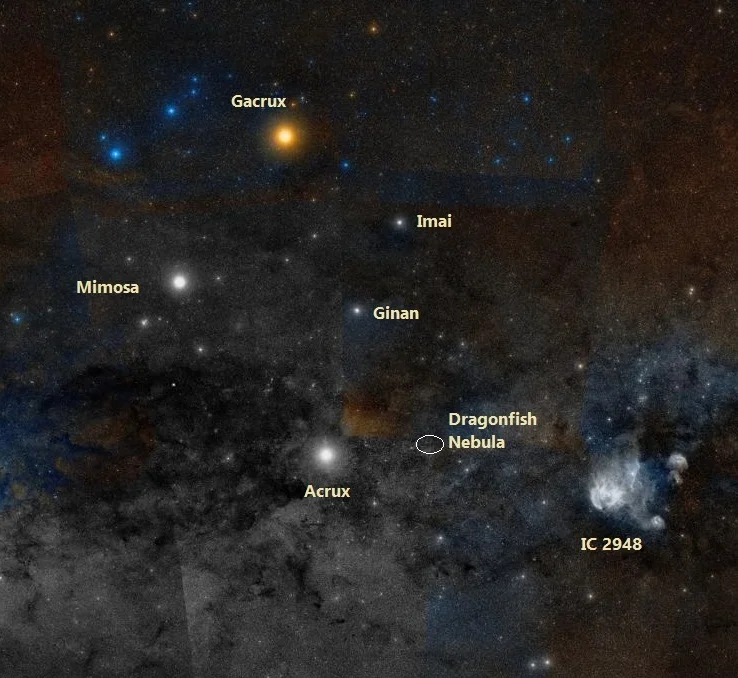The Dragonfish Nebula is a vast emission nebula located in the constellation Crux. Invisible in visible light, the nebula got its name because its appearance in infrared images resembles that of the deep-sea dragonfish. The nebula stretches across 130 arcminutes of the sky and lies at a distance of 30,000 light years from the Sun.
The Dragonfish Nebula is a massive star-forming region that hosts some of the Milky Way’s most massive stars. The two largest stars, which mark the eyes of the Dragonfish, are believed to be very young. The luminous stars embedded in the nebula heat up the surrounding clouds of gas, making the nebula glow in infrared light.

This infrared image from NASA’s Spitzer Space Telescope shows the nebula nicknamed “the Dragonfish.” This turbulent region, jam-packed with stars, is home to some of the most luminous massive stars in our Milky Way galaxy. It is located approximately 30,000 light-years away in the Crux constellation. Image: NASA/JPL-Caltech/Univ. of Toronto
The nebula cannot be seen in visible light because it lies at a great distance, across the Milky Way disk, and is heavily obscured by interstellar dust. Infrared observations with the Spitzer Space Telescope have yielded a physical size of 450 light years for the nebula.
The Dragonfish has a large cavity about 100 light years across, produced by the powerful stellar winds of the massive newly formed stars embedded within the nebula. The shell carved out by the young stars forms the mouth of the Dragonfish.
The nebula was discovered in 2010 by the astronomers Mubdi Rahman and Norman Murray from the University of Toronto. Since the discovery, more than 400 stars have been detected in the nebula. The Dragonfish region is believed to also contain many smaller stars embedded in the clouds. Only the nebula’s most luminous stars are visible due to extinction and distance.
A study published in 2011 identified 406 O- and early B-type stars in the nebula, more than enough to make the Dragonfish a candidate for the most luminous and massive OB association in the Milky Way.
This was confirmed spectroscopically in a subsequent study, which demonstrated the existence of an OB association with 100,000 solar masses. The study showed that the nebula was an OB association and not a chance overdensity and identified 18 massive young stars from a sample of 50 members. The sample included two candidate luminous blue variables (LBVs), a Wolf-Rayet star, and 15 O-type stars.
Even though young stellar associations with masses of more than 10,000 solar masses were already believed to exist in our galaxy, they had not been previously detected. The only cluster with a mass comparable to the Dragonfish Association is the Ara Cluster (Westerlund 1), a young super star cluster with a mass of 63,000 Suns. Named after its host constellation (Ara, the Altar), the Ara Cluster is composed of many blue, yellow and red hypergiant stars, as well as Wolf-Rayet stars and luminous blue variables. One of the cluster members, the red supergiant Westerlund 1-26, is one of the largest known stars, with a size between 1,165 and 1,221 solar radii.
A study published in 2015 suggested that there were other clusters in the same region of the sky as the Dragonfish Association that may power the nebula. One of these, the massive young cluster Mercer 30, was also found to host Wolf-Rayet stars. The study confirmed the cluster’s membership in the Dragonfish star-forming region and identified a total of 19 young clusters and candidate clusters that contribute at least 73% of the ionization of the nebula.
The study suggested that the presence of these massive young clusters left little to no room for the superluminous Dragonfish Association, which led the authors to conclude that the stellar overdensity discovered a few years earlier could be a foreground feature consisting of late-type stars. Additionally, the study demonstrated that the Dragonfish Nebula may be one of the largest and most massive star-forming regions in our galaxy, stretching about 400 parsecs across.
Location
The Dragonfish Nebula is located in the far southern sky, at the edge of the Sagittarius-Carina spiral arm. If it were visible, it would be very easy to find because it lies near the Southern Cross, one of the most familiar southern asterisms. The nebula is located just west of Acrux, the brightest star in Crux and 13th brightest star in the sky.

Dragonfish Nebula location, image: Wikisky
Dragonfish Nebula
| Constellation | Crux |
| Right ascension | 12h 11m 27.5s |
| Declination | −62° 55′ 10″ |
| Distance | 32,000 light years (9,700 parsecs) |
| Angular size | 130 x 130 arcminutes (infrared) |
| Names and designations | Dragonfish Nebula, Dragonfish Association, GAL 298.4-00.4 |